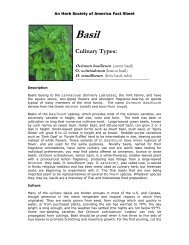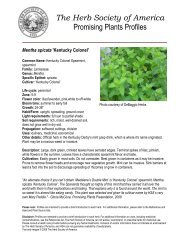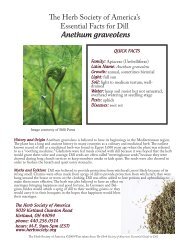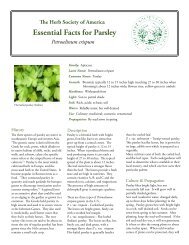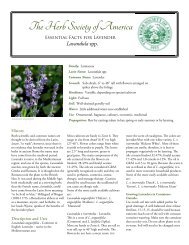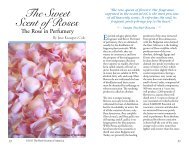rosemary fact sheet.indd - The Herb Society of America
rosemary fact sheet.indd - The Herb Society of America
rosemary fact sheet.indd - The Herb Society of America
Create successful ePaper yourself
Turn your PDF publications into a flip-book with our unique Google optimized e-Paper software.
<strong>The</strong> <strong>Herb</strong> <strong>Society</strong> <strong>of</strong> <strong>America</strong>’s<br />
Essential Facts for Rosemary<br />
Rosmarinus <strong>of</strong>ficinalis<br />
QUICK FACTS<br />
Family: Lamiaceae (Labiatae)<br />
Latin Name: Rosmarinus <strong>of</strong>ficinalis<br />
Growth: evergreen perennial<br />
Hardiness: zone 8-10<br />
Light: full sun<br />
Soil: well-drained, sand or gravel mix<br />
Water: slightly moist, not too wet<br />
Pests: thrips, spider mites, white fly<br />
Diseases: root rot<br />
Propagation: cuttings, layering, seeds<br />
(species only)<br />
Use: culinary, landscaping, crafts<br />
History and Origin: Rosemary is native to the dry, rocky<br />
areas <strong>of</strong> the Mediterranean, especially along the coast. <strong>The</strong><br />
genus name Rosmarinus derives from the Latin words ros and<br />
marinus which together translate to “dew <strong>of</strong> the sea.” Rosemary<br />
has been used since the time <strong>of</strong> the early Greeks and Romans.<br />
Greek scholars <strong>of</strong>ten wore a garland <strong>of</strong> the herb on their heads<br />
to help their memory during examinations. In the ninth century,<br />
Charlemagne insisted that the herb be grown in his royal<br />
gardens. <strong>The</strong> Eau de Cologne that Napoleon Bonaparte used<br />
was made with <strong>rosemary</strong>. <strong>The</strong> herb was also the subject <strong>of</strong><br />
many poems and was mentioned in five <strong>of</strong> Shakespeare’s plays.<br />
Myths and Folklore: A sprig <strong>of</strong> <strong>rosemary</strong> was <strong>of</strong>ten<br />
placed in the hands <strong>of</strong> the deceased at a funeral because it is a<br />
symbol <strong>of</strong> remembrance. Brides <strong>of</strong>ten wore <strong>rosemary</strong> at their<br />
weddings because it was also a symbol <strong>of</strong> happiness, loyalty<br />
and love. Legend has it that <strong>rosemary</strong> originally had white<br />
flowers which were changed to blue ones when the virgin Mary<br />
placed her cloak upon it while resting during her flight to<br />
Egypt.<br />
All images: Robin Siktberg ©2009<br />
<strong>The</strong> <strong>Herb</strong> <strong>Society</strong> <strong>of</strong> <strong>America</strong> ©2009/www.herbsociety.org
Cultivation: Rosmarinus <strong>of</strong>ficinalis does<br />
well if grown in pots or containers. Provide<br />
winter protection if the plant is left outside.<br />
This herb is especially susceptible to root rot<br />
if it is overwatered. Use a light, well-drained<br />
soil with some added sand or gravel and wait<br />
to water until the soil is slightly dry. Prune<br />
to encourage branching and to remove dead<br />
leaves and stems. Growing <strong>rosemary</strong> indoors<br />
can be challenging but it is well worth the<br />
effort. Indoor plants benefit from a sunny<br />
window in a cool room, well-draining soil, and<br />
regular misting.<br />
Robin Siktberg ©2009<br />
How is <strong>rosemary</strong> used? Rosmarinus <strong>of</strong>ficinalis has a myriad <strong>of</strong> uses for the cook, crafter and landscaper.<br />
This strongly flavored herb should be used sparingly for cooking. Poultry, fish, lamb and beef are all enhanced<br />
by its pungent flavor. In addition, try it with tomatoes, cheese, eggs, potatoes, squash, soups and salad<br />
dressings. Well-developed woody stems can be used as skewers for shish kebobs. In the landscape, <strong>rosemary</strong><br />
is <strong>of</strong>ten used to make to make topiaries and hedges. <strong>The</strong> herb can be planted along stone walls or pathways<br />
and it grows well in containers. Crafters use <strong>rosemary</strong> to make wreaths, garland, and bath products. <strong>The</strong> plant<br />
also produces a yellow-green colored dye and is used in aromatherapy.<br />
How do I harvest Rosemary? Be sure to harvest<br />
only well-established <strong>rosemary</strong> plants. It is best to wait<br />
until any new growth has hardened <strong>of</strong>f, usually in summer<br />
and early fall. Avoid harvesting while the plant is blooming.<br />
<strong>The</strong> prime time for harvesting <strong>rosemary</strong> for optimum<br />
flavor is just prior to flowering. Cut the stems above the<br />
woody growth and avoid dry, brown or yellowing leaves.<br />
If you plan to take your <strong>rosemary</strong> indoors for the winter,<br />
be sure to minimize your trimming during the fall to allow<br />
it to regain its strength for the winter. Keep in mind<br />
the desired shape <strong>of</strong> your plant as you harvest and avoid<br />
overpruning. Yellowing or dead branches can be removed<br />
at anytime.<br />
What about drying and storage? Dry <strong>rosemary</strong><br />
quickly to help retain its green color and essential<br />
oils. Longer stems can be hung upside down in a dark<br />
area with good air circulation. Smaller stems can be<br />
placed on screens. Rosemary can be frozen, although<br />
some loss <strong>of</strong> color may occur. To freeze, place the<br />
sprigs on a cookie <strong>sheet</strong> that has been covered with<br />
waxed paper or place in a ziploc® bag. Strip <strong>of</strong>f the<br />
leaves when they are frozen and store in an airtight<br />
container. Leaves can also be placed in ice cube trays<br />
with some olive oil and stored in ziploc® bags after they<br />
are frozen.<br />
Robin Siktberg ©2009<br />
<strong>The</strong> <strong>Herb</strong> <strong>Society</strong> <strong>of</strong> <strong>America</strong> ©2009/www.herbsociety.org





